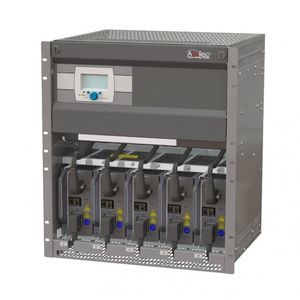
- Company
- Products
- Catalogs
- News & Trends
- Exhibitions
DC uninterruptible power supply AUPUS WRSindustrialfor telecom applicationsfor railway
Add to favorites
Compare this product
Characteristics
- Electrical characteristics
- DC
- Applications
- industrial, for telecom applications, for railway
- Configuration
- wall-mounted
- Output power kVA
Max.: 2 kW
(2.719242 hp)Min.: 1.5 kW
(2.039432 hp)- Input voltage
Max.: 300 V
Min.: 85 V
- Output voltage
Max.: 220 V
Min.: 24 V
- Power
Max.: 2,000 W
Min.: 1,500 W
Description
AUPUS WRS Wall Mounted Chargers are robust and free convection cooled backup power solutions. Together with external battery bank it provides reliable and cost-effective uninterrupted DC supply for critical infrastructure applications such as transmission and distribution substations, process industries, railway signalling and telecommunications.
AUPUS WRS DC power systems consist of MHE rectifiers, VIDI+ controllers, Connections for mains and battery and load distribution MCB.System is configurable to meet requirements of the application. On top of 12 configurable relay alarms, system can be remotely monitored via modern communication protocols such as Ethernet TCP/IP, Modbus TCP/IP, SCADA IEC61850, SNMP and RS-232.
Specifications
- Efficiency up to 97%
- Convection cooling – no fans
- Outputs 24, 48, 60, 110, 125, 220 VDC
- Easy installation
- Battery MCB for one string
- Mains switch and MCB, Load MCB
- Configurable A+B double charger set-up
- VIDI+ I/O controller, local and remote interfaces 4 x relays, Ethernet, Modbus, SNMP, RS-232
Option:
- Battery LVD, battery temp.sensor, SCADA IEC61850
Safety:
- EN61439-1, EN61439-2
- Low voltage switchgear controlgear assemblies
EMC:
- Cabinet: EN61439-1, EN61439-2
- Rectifiers: EN 61000-6-1 / -2 / -3 / -4 / -5
- ETSI EN 300386 (48/60V)
Catalogs
Datasheet AUPUS WRS
4 Pages
Related Searches
- Power supply
- AC/DC power supply
- CE power supply
- Single-output power supply
- Battery charger
- Power supply with overload protection
- DIN rail power supply
- Compact power supply
- On-line uninterruptible power supply
- Adjustable power supply
- Lithium battery
- 12 V battery
- IEC battery
- Lead battery
- AC uninterruptible power supply
- Programmable power supply
- CE battery
- Industrial uninterruptible power supply
- High-performance battery
- Lead battery charger
*Prices are pre-tax. They exclude delivery charges and customs duties and do not include additional charges for installation or activation options. Prices are indicative only and may vary by country, with changes to the cost of raw materials and exchange rates.









